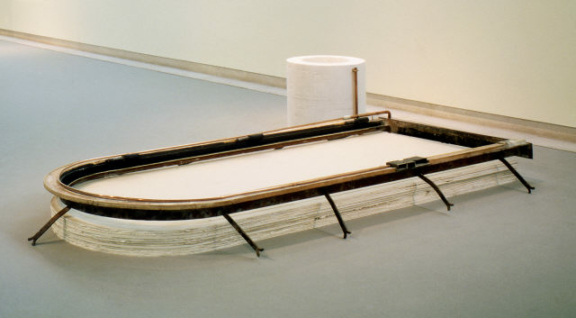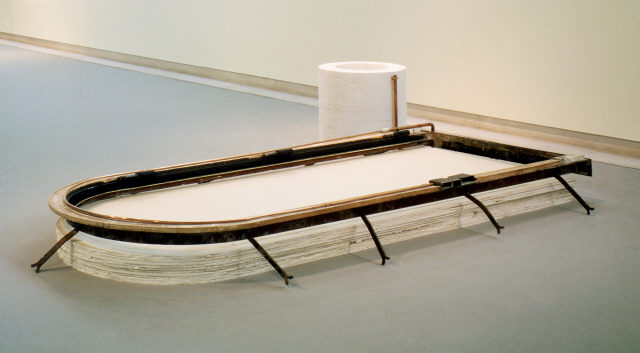
- 1990
- Plaster, Door frame, Copper and Plaster
- A definir
- Inv. 94E343
Pedro Cabrita Reis
D(OOR), D(AM)
Fountain, well, canal, dam, silo, house, stairs, step, door, fireplace, table, chair, bench, basket, jug constitute an alphabet of references and forms on which Pedro Cabrita Reis has based his work since the early 1990s.
D(oor) D(am) belongs to the inaugural series of works based on this fundamental lexicon: 67 objects/ constructions/installations highlighted by the publication of an artist’s book1. With this book, Cabrita Reis consolidated the idea that a change had taken place in his visual enquiries, as the practice of painting and drawing he had given prominence in the 1980s, was now giving way to the production of works which allude to this basic alphabet, by diversifying the techniques and materials used. Far from establishing any defined disciplinary categorisation, the line of enquiry opened by Cabrita Reis in the 1990s made use of recovered of common materials and explored the intersecting nature of a world of references, densifying and overlapping its possible meanings. In several works, a vital relationship between the work and the space hosting it is also accentuated [see Alexandria (1990) in the Convent of Saint Francis in Beja].
The works in which we can see this change are constructed on the basis of an (expanding) universe of familiar materials: from architecture dominated by the visual impact of plaster to the civil engineering construction site and the recovery of everyday objects (the jug and baskets mentioned above but also, shortly afterwards, the use of light bulbs or fabrics). At first sight, these raw materials suggest common, familiar situations. However, we quickly become aware of their strangeness. The «dislocation of meaning that defines the work of art» [2] has stripped these elements of their common dimension, of the meaning usually conferred on them, forcing us to multiply the number of interpretive possibilities and deal with the instability of the potential meanings.
In D(oor) D(am), the functional and symbolic memory of the main function of the door has been intentionally disturbed by the overlaying of other meanings: on the one hand, the value of the objet trouvé has been recovered, on the other hand, Cabrita Reis in no way ceases to highlight the transformation induced by his creative intervention and, therefore, the dislocation of meaning that defamiliarises the door frame, the cutted plasterboards, and the circular shape of the hypothetical well. The «absolute desire for metaphor» is therefore fulfilled [3] in the objective randomness inherent in the encounter between a dam and a door: «A dam separates the water from the earth; a door separates the inside from the outside. In Amsterdam, the canals are arranged almost in a U-shape, visibly parallel and concentric. The design of an Amsterdam canal is found in the door from Amsterdam. A strange convergence or a constructive matrix?» [4]
D(oor) D(am) is therefore the door-dam that receives the waters emptied by the adjacent reservoir-well. Far from expressing any explicatory, descriptive, or illustrative intention, this work clarifies the artist’s investment in the expanding number of possible ways of constructing the world. The essential ambiguity in play in this work, as in almost all of Pedro Cabrita Reis’s other work, contributes decisively to the dismantling of the idea of a universe in which meaning is natural and supposedly stable.
Joana Cunha Leal
May 2010
1 Pedro Cabrita Reis, Lisbon, CAM – Fundação Calouste Gulbenkian, 1992.
2 Idem, p. 36.
3 Idem, p. 148.
4 Idem, p. 72.
| Type | Value | Unit | Section |
| Height | 70 | cm | |
| Width | 380 | cm | |
| Depth | 173 | cm |
| Type | Acquisition |
| Hors Catalogue - Un projet Gulbenkian à propos de sa collection |
| Amiens, Maison de la Culture d'Amiens, 1997 |
| ISBN:2 903082 70 8 |
| Catálogo de exposição |
| Extremo Occidente - Arte Portugués Contemporáneo en la Fundação Calouste Gulbenkian |
| Bilbao, Sala de Exposiciones REKALDE, 1995 |
| Catálogo de exposição |
| Tríptico |
| Gand, Museum Van Hedendaagse Kunst, 1991 |
| Monografia |
| Pedro Cabrita Reis |
| Lisboa, Centro de Arte Moderna - Fundação Calouste Gulbenkian, 1992 |
| Catálogo de exposição |
| Contra a claridade |
| Lisboa, Centro de Arte Moderna - Fundação Calouste Gulbenkian, 1994 |
| Catálogo de exposição |
| Pedro Cabrita Reis |
| Valencia, IVAM, 1996 |
| Catálogo de exposição |
| Tage der dunkelheit und des lichts: zeitgenössische Kunst aus Portugal |
| Bonn, Bonn: Kunstmuseum, 1999 |
| Catálogo de exposição |
| Pedro Cabrita Reis |
| Ostfildern-Ruit, Ostfildern-Ruit: Hatje Cantz Verlag, 2003 |
| Monografia |
| Pedro Cabrita Reis - Contra a Claridade |
| CAMJAP/FCG |
| Curator: CAMJAP/FCG |
| 24 de Maio de 1994 a Julho de 1994 Galeria do Piso 1 do museu do CAM |
| Exposição comissariada por Jorge Molder, José Sommer Ribeiro e Pedro Cabrita Reis. |
| Hors Catalogue - Un projet Gulbenkian à propos de sa collection |
| CAMJAP/FCG |
| Curator: João Fernandes |
| Dezembro de 1996 a Fevereiro de 1997 Casa da Cultura de Amiens, França |
| Uma co-produção da Casa da Cultura de Amiens e do Serviço de Belas-Artes e do CAMJAP da Fundação Calouste Gulbenkian.Esta exposição tem origem numa proposta de Augusto Rodrigues da Costa, responsável pela programação de artes plásticas da Casa da Cultura de Amiens. |
| Cabrita Reis, Sculptures |
| Barbara Farber Gallery |
| Curator: Barbara Farber Gallery |
| 1990 a 1990 Barbara Farber Gallery, Amesterdão |
